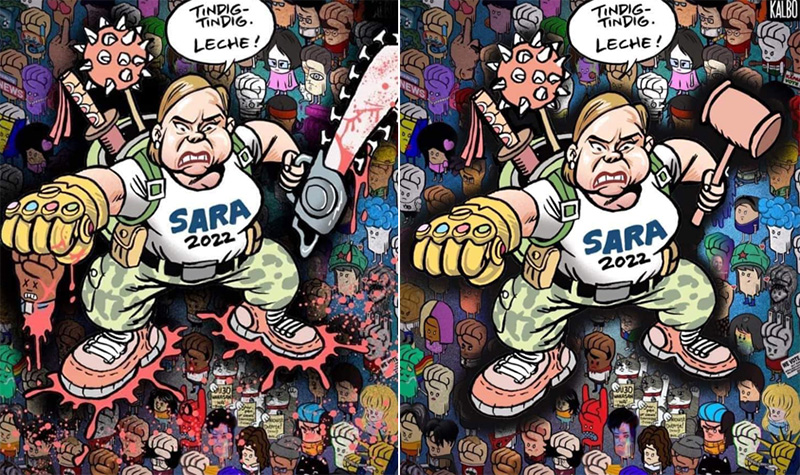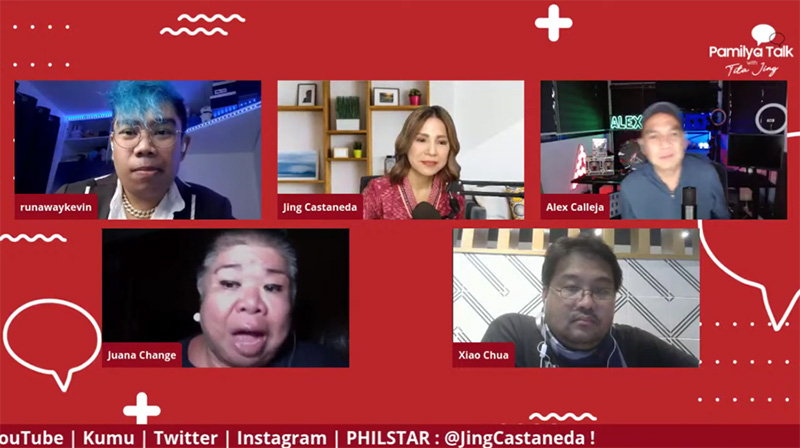Protesting thru art in the digital age


Turning viral more than a week ago and in time for President Rodrigo Duterte’s last State of the Nation Address was a series of customizable cartoon templates—all showing a raised fist amid rows of fist bumps, one popularly associated with our iron fist leader and his supporters. Artist-activist Kevin Raymundo (aka Tarantadong Kalbo) was the man behind the series, one that then initiated more artists, brands, and different communities online to come up with their own versions to express dissent.
It’s obviously not the first kind of online protest art we’ve seen. But next to retweets, regrams, and temporary Facebook profile photo stickers done many times over to help protest or convey opinion, Tarantadong Kalbo’s creation is one of the more recent and original ones that still struck with a simple but powerful message: “Tumindig.” In English, it meant stand up, or rise above. The radical artwork shook the online world by storm, a major deal for a country considered to be the world’s social media capital.
In contrast to, say, protest pieces in text or video formats that may take more time and effort to consume by the average social media user, something as direct and visual as a Raymundo’s art card quickly spoke a statement. The quicker then it also spread. In interviews, the artist himself said he didn’t expect how far his concept’s reach has gotten.
As how “Tumindig” inspired many to create their own art cards online, I was also roused to discuss with other local artists on using art in social and political talks. What is protest art? How do we create our own protest art? How we do make sure its message is conveyed especially in a realm as noisy, polluted, and possibly corrupt as social media? How do we know which one is propaganda? In our recent “Pamilya Talk” episode, I had the opportunity to exchange views about something that will become more timely in the coming months, with some of the most influential: Performance artist Mae Paner (Juana Change), comedian-writer Alex Calleja, and historian Xiao Chua. Read on.
Protest art in history
It’s not just some papansin stunt to convey a reklamo. No. Instigating social movements through creative work, in fact, has marked the most important events of our time and led to why we now enjoy democracy in the first place. From Marcelo H. Del Pilar’s “Aba Ginoong Barya” in the Spanish era to Willie Nepomuceno’s impersonations in the Philippines’ years of dictatorship under Ferdinand Marcos, protest art has always been founded on lending the masses a voice. “Satire is a political weapon especially of the weak,” Chua states.
Likewise, the reason we see most protest art hitting those in power traces back to history, with the voiceless finding vehicles and ways to speak out. Humor in art, for example, has always been good natured even when talking about bigger, deeper issues, says Chua. “Usually ang literature at focus ng media ay sa protest art, kasi nga wala tayo sa may kapangyarihan.”
It eventually became something else when the powerful themselves used it to their advantage, the De La Salle University professor stresses.

“It is also appropriated by the powerful,” he says, citing as an example one likewise viral artwork Duterte supporters have shared online. The art showed Sara Duterte as a chainsaw-wielding Thanos, a super villain who had a mission to kill half of the population across the universe in Disney’s Marvel Cinematic Universe.
Chua adds, “Merong nga dyaryo tayo sa Pilipinas na pro-government. Dun mo makikita yung mga editorial cartoons nila.”
“Nakikita mo ang political propagranda sa art, nandyan yan sa political campaigns pagka-eleksyon, gaya ng ‘Budots Dance’ (ni Bong Revilla). Nasa dancing kung paano magpista ang Pilipino. Kahit ang SONA, larangan yan ng both the opposition at administration na nag-fashion show at mag-protest fashion. Yan yung nakikita natin na ginagamit ng iba’t-ibang sektor kasi napakapangyarihan ang art.”

Using protest art to initiate conversations
It shouldn’t just be about liking or sharing art. Says Paner, what’s more important is engaging with the community about the idea behind your art.
“Mahalaga ang galit. Anger has a place. Pero pag ang iluluwa mo ay galing sa galit, hindi malayo ang nararating niyan kasi galit ka. Kaya ako, I really like to engage in conversations, lalo na pag may respeto.”
Adds the artist, known for her cosplay work since the Marcos time, “Ang point ko ngayon, I don’t need to win arguments, i would rather win hearts. Lahat ng tao ngayon, gustong manalo sa argumento. Pero pag nanalo ka ng argumento, kaaway mo pa rin yon. Samantala, if you’re discussing and you convince each other na, ‘Okey yang position mo, ito naman ang position ko,’ pwede naman tayong magpatuloy ng pag-uusap. Nag-bi-bridge ka eh.”
Thus, Paner emphasizes, artists should listen, too.
“May meeting point yan. We are all human and at the same time we are really all connected. Ang mga tao, masyado nilang inaalagaan yung mga pain nila and past nila. Instead, ang iniisip (dapat) nila ay ang kinabukasan. When you’re conversing with the future, dun ka pumipitas ng inspirasyon ng gusto mong klaseng mundong makita. Dun I think malalagpasan mo ang galit mo. (Kasi kung hindi) hindi tayo makakausad.”
Paner herself heads a community kitchen, from her own keep, serving the urban poor and other marginalized individuals whom she then includes in conversations.
Following these healthy discussions, Calleja says as the next step, should be the application in the real world.
“Get out of social media. Talk to people face to face,” he says. “Ginagamit (ang social media) dapat sa kabutihan but this is (now) used for something esle. This (should be) a productive medium. It’s nice for you to promote your craft and give people equal opportunity kahit di ka celebrity o star. Pero yung other side ng coin, binigyan din natin yung tao ng power to promote kung ano man ang opinyon nila whether they’re right or wrong.”
Protest art will always be there
There was, is, and will be no perfect government, Chua says, even mentioning the Hegelian dialectic (“Thesis plus antithesis equals synthesis”) as the rule of life. That said, protest art will always exist, but only for the greater good. Thus, those subjected to these should best take it in only as constructive criticism.
“Walang perfect unity sa isang bansa. Walang ganun. Lahat tayo, may kanya-kanyang pag-iisip. Pangit naman yun pag iisa ang pag-iisip natin. Wala nang improvement,” he says. “Ang problema lang yung pagiging toxic. There should be decency in discourse. We can talk as a nation even if we are diverse.”
The three then call on for more artists to follow suit—to be the next Tarantantadong Kalbo in the online age, especially now when it’s fairly easy to spread fake news, terror, and, of course, propaganda.
Paner cries, “May mga Pinoy artists na mas gusto nilang maging safe, mas gusto nilang matakot at wag kumibo. Kaya yung mga katulad na artista na talaga namang tumataya, they’re really putting themselves out there—dapat naman lang talaga na suportahan. Yun talaga ang kailangan natin sa panahong ito. Tapang na may kailangang galing.”
“The more we are out there, the more na nakikita tayo ng tao, mas nakakatulong na maging proteksyon natin yan. Kasi sa totoo lang, mas madaling kunin yung mga tahimik, yung mga papasukin nalang sa bahay. Pero for the likes of us na nakikita nilang laging nasa labas magmula nung mga nakaraang adminstrasyon—Marcos palang, ginagawa ko na to, eh! Kayo nga aalis na ulit, eh. Ako nandito lang ako,” she says with a laugh.
---
Please watch Pamilya Talk on Facebook, YouTube, and Kumu (@JingCastaneda – 5:30-7:00 p.m. Monday, Tuesday & Wednesday). Please share your stories or suggest topics at jingcastaneda21@gmail.com. You can also follow and send your comments via my social media accounts: Instagram, Facebook, YouTube, Twitter and Kumu.



















